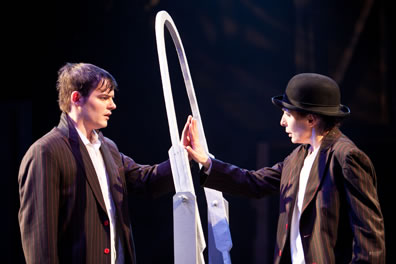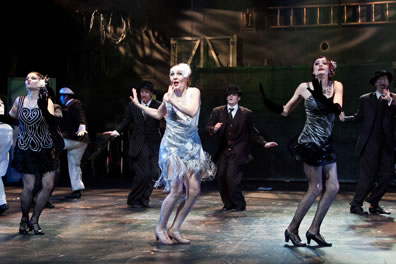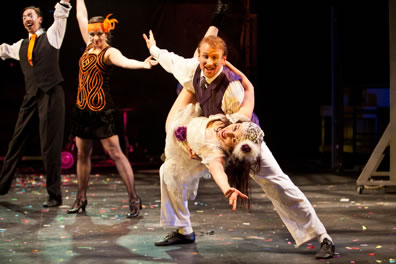Twelfth Night
A Suitable Excuse for Silent Movie Hijinks
Synetic Theater, Arlington, Va.
Thursday, January 9 2014, J–108&109 (center stalls)
Directed by Paata Tsikurishvili

Sebastian (Alex Mills, left) and Viola (Irina Tsikurishvili) in the Synetic Theater production of Twelfth Night connect through their reflections as both think the other is dead. The Roaring Twenties-set play is the 10th in the company's Silent Shakespeare series. Photo by Koko Lanham, Synetic Theater.
Take some parts Shakespeare and a heaping helping of Dancing with the Stars, throw in a good measure of Charlie Chaplin and dashes of Buster Keaton, and out comes a tasteful concoction called Synetic Theater's Twelfth Night. Turning the story of identical twins Viola and Sebastian into matter for a silent movie, the self-proclaimed "movement-based theater company" has created a hybrid play that reflects on the underlying themes of Shakespeare's original while serving up a rousing good time. Ending your performance with an all-ensemble Lindy hop and jitterbug guarantees sending your audience bopping to the exits.
This is Synetic Theater's 10th entry in its Silent Shakespeare series adapting Shakespeare's text into dance and mime. Twelfth Night departs from the company's typical Silent Shakespeare formula in one significant way: instead of ballet and Cirque du Soleil–style acrobatics, the choreography by Irina Tsikurishvili (who plays Viola) uses Roaring 20s dances, including the Charleston, foxtrot, and cakewalk. This Silent Shakespeare production is also the first I've seen that actually includes portions of Shakespeare's texts: Key lines show up on a movable screen as silent movie dialogue title cards. Ironically, these infusions of real text are the show's only missteps as they seem forced into moments that don't really need the sentiments inscribed for us; the actor/dancers need no words.
Director Paata Tsikurishvili—who, with his wife Irina, founded the company—often takes some curious liberties with Shakespeare's stories, and this Twelfth Night marks the biggest departure from the original storyline I've yet seen in his retellings. However, he astutely captures in movement and staging Shakespeare's allegorical arcs and metaphors. His primary visual motif for Twelfth Night is self-reflection. After their forced parting in the sea storm, Viola sees Sebastian in a mirror, and Irina Tsikurishvili and Alex Mills, respectively, dance a kind of pas de deux in these moments with the oval mirror set between them. It's elegiac, it's mournful, and it results in displaying Viola's courageous resolve to carry on. When Sebastian arrives in Illyria, Mills literally steps through the mirror; though Viola does not know it yet, the ghost that is in her own reflection has come to real life.
The mirror shows up at another significant point. After Malvolio (Irakli Kavsadze) has been punked and is hospitalized in an institution as part of the prank, Feste (Ben Cunis) disguised as Sir Topaz forces Malvolio—wearing leather lederhosen shorts and yellow garters not only crossing his legs but his belly, too—to look in the mirror. Malvolio hates so much what he sees that he tries to avoid the reflection, but Feste/Topaz keeps moving the mirror in front of him. At play's end, Malvolio resumes his place in Olivia's household and in her opinion; the lesson he has learned is a reflective one. This may not be Shakespeare's intent, but portraying the precarious ledge upon which self-esteem strolls is the aspect of the play's subplot Paata Tsikurishvili wants to highlight in his rendering.
This Twelfth Night's story begins prior to the shipwreck as the twins appear as star dancers performing for the passengers in a cabaret-style dance of confusion. After the shipwreck, they do a balletic sequence of separation, and Viola ends up clinging to a floating suitcase (the buoying effect created through dance). That suitcase happens to contain her costume (a three-piece man's suit) from the skit she performs with her brother, so she dons it to create her disguise as Cesario and heads into town. She peers into a home and sees Olivia rejecting Orsino (Kathy Gordon and Philip Fletcher, respectively), and when Orsino is sent packing, he encounters Cesario. They become bosom buddies, and she coaches him on how to court women via a humorous foxtrot in which each takes turns dancing the lead. Orsino sends Viola/Cesario to Olivia on his behalf, and Olivia becomes smitten with Cesario.
Much of what ensues is reminiscent of Chaplinesque silent movies. When Olivia sends Malvolio after Viola with her ring, Malvolio tries to give it to Sebastian first, who refuses it and leaves whereupon Viola immediately appears and takes the ring from a confused Malvolio. Olivia tries to pin Viola down on the settee, and then, in a subsequent scene, a confused Olivia in her bed has to escape Malvolio's yellow cross-gartered advances. The duel between Olivia and Aguecheek (Dallas Tolentino) is a boxing match based on the Little Tramp's bout in City Lights. Orsino happens upon Olivia with Sebastian—both Orsino and Olivia thinking he's Cesario—and we get an extended replication of the twins' opening act skit, the brother and sister entering one door as the other exits another door, Viola trying to avoid the clutches of Olivia and the inexplicable anger of Orsino, and Sebastian trying to protect Olivia while fending off Orsino.
It's not enough that the action here resembles a Keystone comedy. Though the production tracks with the original's plot, the silent movie setting is more instructive to the action on the stage than Shakespeare's dramatic progression. The play takes place on a working movie studio set designed by Phil Charlwood: furniture and other props are on wheels and become dance partners for the ensemble fluidly moving them in and out of scenes. The whole play is set in the framework of Feste and Fabian (Vato Tsikurishvili) making a movie. For the shipwreck, they film a toy ship plunging into a water tank as the rest of the ensemble scramble back and forth like Enterprise crewmen under attack. They film Viola stranded on the shore as Feste creates the effects of snow falling on her. They film Viola with her reflection. However, the two filmmakers also become players in the Malvolio subplot.

 Top, Viola (Irina Tsikurishvili) leads the ensemble in a dance on the cruise ship; bottom, she and Orsino (Philip Fletcher) center the big finale dance, the costumes transitioned from black and white to technicolor, in Synetic Theater's production of Twelfth Night. Photos by Koko Lanham, Synetic Theater.
Top, Viola (Irina Tsikurishvili) leads the ensemble in a dance on the cruise ship; bottom, she and Orsino (Philip Fletcher) center the big finale dance, the costumes transitioned from black and white to technicolor, in Synetic Theater's production of Twelfth Night. Photos by Koko Lanham, Synetic Theater.All of the characters except Viola and Sebastian sport clown makeup, but they wear authentically rendered Roaring Twenties costumes designed by Kentra Rai, who adds the clever touch of using shades of black and white until the technicolor finale. The soundtrack under the direction of Kavsadze (supplemented with original music by Konstantine Lortkipanidze) is mostly ragtime.
In addition to Chaplin's mannerisms, Irina Tsikurishvili draws on Little Tramp-like pathos in her performance of Viola longing for Orsino but pursued by Olivia. Fletcher is a charming cad, his ways with women so ridiculously debonair that we can't help smile at him and share in Viola's affection. Gordon's Olivia starts as a sobbing woman mourning her brother's passing, which she watches incessantly on her home entertainment system circa 1920s (a clever device of the ensemble acting behind the screen on stage). But she turns sex kitten in flapper underwear after Cesario comes on the scene. Mills does jaw-dropping work as Sebastian, especially in the opening cruise ship cabaret sequence when he moves his body as if aligning parts of a puzzle and grapples with a balloon as if it were a 500-pound ball with a mind of its own. Mills' performance is more reminiscent of 1920s movie cartoons than Keaton.
By the end of the play, we've pretty much left Shakespeare behind, until the twins finally end up on the stage at the same time. That reunion scene is powerful stuff as the siblings emerge in wonder out of the certainty that the other is dead and the confusion they have unwittingly wrought. They repeat their self-reflection moves from earlier, but now without the mirror between them. When Viola removes her wig and reveals her long hair, her courage and her caring come to instant fruition, and Paata Tsikurishvili brings Twelfth Night's thematic strands to a most satisfying end.
Well, it's not really the end. Paata turns the reins over to choreographer Irina for the big send-off dance featuring the whole cast individually, in pairs, and as one whole. It more than caps off a fun adaptation of a great play; it is by itself worth the price of admission and will please you every way.
Eric Minton
January 18, 2014
Comment: e-mail editorial@shakespeareances.com
Start a discussion in the Bardroom



 Find additional Shakespeareances
Find additional Shakespeareances